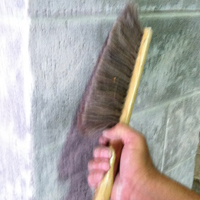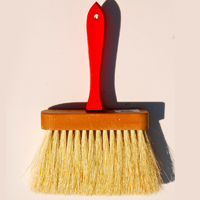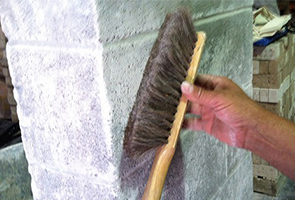If you have a choice, a brush with power grip handle will reduce the amount of force needed and may allow you to minimize the time spent with your wrist in a bent position. If there are two handle grip sizes available and your grip is in between, consider modifying the handle or handle area to fit.
Modify the grip -
- If the handle is too large for your hand, you might be able to sand down a wood handle to a smaller grip size. But be careful, reducing the size could affect the handle’s strength and increase the chance of it breaking.
- If the handle grip size is too small for your hand, you can apply a tool sleeve or use a padding kit, such as the IMPACTO Tool Wrap ORTHEX Grip Kit* to increase the size of the handle. Wearing gloves may also help since they typically reduce your effective grip size. Depending on the materials and products you are working with a specific type of glove may be recommended or required to protect your hands from skin disorders, such as burns and dermatitis or other injuries. Gloves can also protect your hands from the cold. Note: some workers have reported a reduced sense of touch and needing a stronger grip when wearing gloves. Using a tool with a non-slip grip area or adding an anti-slip material may help.
- If you use a broom end in place of a brush and do not have a clear grip area, try to find one that has a space for a secure hand grip (for example, a thicker wood or plastic end), attach tape or a padding material that is less slippery than the handle material, or use non-slip, well-fitting gloves so that you don’t have to grip as hard. Having your hand centered over the broom end may also give better balance and reduce the grip strength needed to use the brush.
If you already have a hand/arm injury or condition such as tendonitis, arthritis, or carpal tunnel syndrome, using a power grip, along with non-slip, well-fitting gloves or an anti- or non-slip grip will allow you to use the brush with the least amount of force.


 A brush with a narrow handle (photo 2), or when part of a brush other than the handle is held, will require more of a precision grip or a modified power grip (photo 3) and greater grip strength. Depending on the shape of the handle and the task being performed a worker may have to work with their wrist bent, which will also increase the grip strength needed.
A brush with a narrow handle (photo 2), or when part of a brush other than the handle is held, will require more of a precision grip or a modified power grip (photo 3) and greater grip strength. Depending on the shape of the handle and the task being performed a worker may have to work with their wrist bent, which will also increase the grip strength needed.
